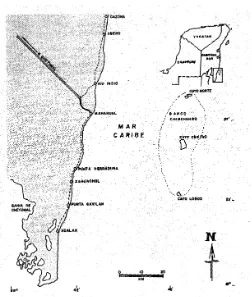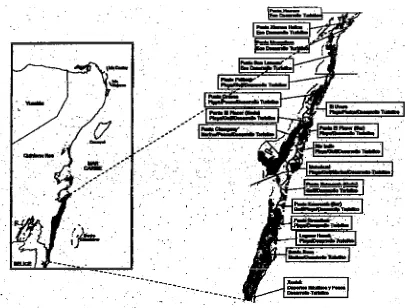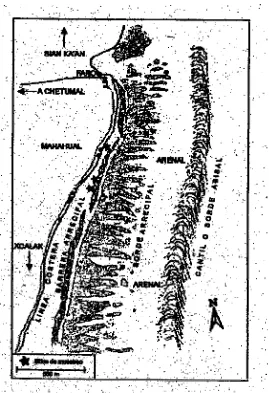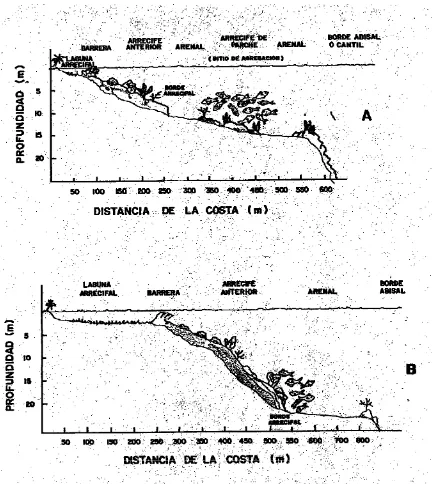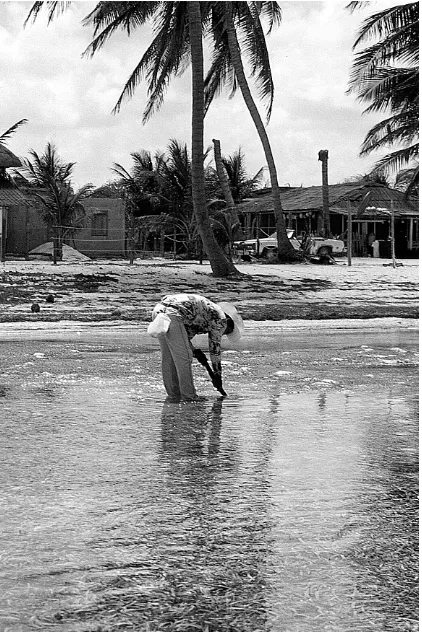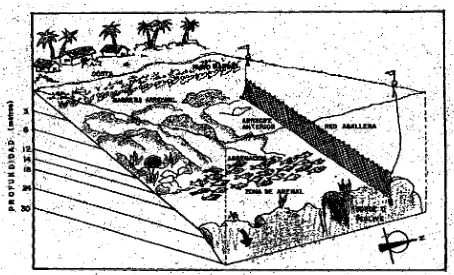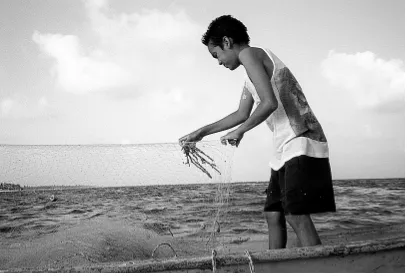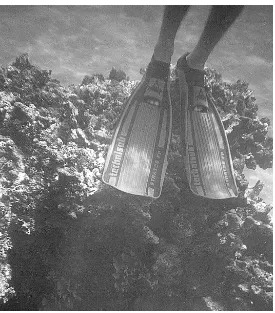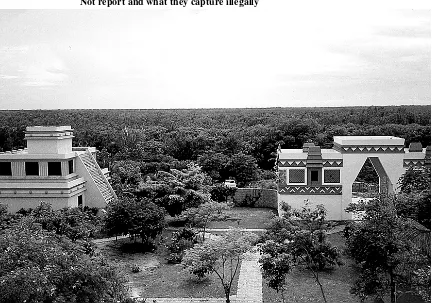_____________________________________________________________________________
Summary Findings: Socioeconomic Aspects of
Resource Use and Perception in Mahahual,
Quintana Roo, Mexico, Nov 1999
_____________________________________________________________________________ Cinner, J.
2000
Citation:
Kingston, Rhode Island USA: Department of Marine Affairs,University of Rhode Island.
For more information contact: Pamela Rubinoff, Coastal Resources Center, Graduate School of Oceanography, University of Rhode Island. 220 South Ferry Road, Narragansett, RI 02882 Telephone: 401.874.6224 Fax: 401.789.4670 Email: rubi@gso.uri.edu
This five year project aims to conserve critical coastal resources in Mexico by building capacity of NGOs, Universities, communities and other key public and private stakeholders to promote an integrated
approach to participatory coastal management and enhanced decision-making. This publication was made possible through support provided by the U.S. Agency for International Development’s Office of
by Joshua Cinner
November 12, 1999
TABLE OF CONTENTS
1.0 INTRODUCTION
2.0 SITE SELECTION AND DATA COLLECTION METHODS 3.0 MAHAHUAL AND SURROUNDING COASTAL ECOSYSTEMS
3.1 OVERVIEW
6.4 SOCIAL STRATIFICATION AND LAND TENURE
6.5 ETHNICITY AND RELIGION
8.0 INTEGRATED COASTAL MANAGEMENT IN THE COMMUNITY
8.1 INTRODUCTION
8.2 PERCEIVED NEEDS AND KEY MANAGEMENT ISSUES
8.3 SUGGESTED INTERVENTIONS
1.0 INTRODUCTION
Amogos de Sian Ka’an, a Mexican Non-Government Organization (NGO), has begun to promote Integrated Coastal Management (ICM) as a means to conserve coastal resources and increase the quality of life in the village of Mahahual, Quintana Roo, Mexico (figure 1). The purpose of this report is to provide baseline information on socioeconomic aspects of coastal resource use and perception to be utilized by Amigos de Sian Ka’an in the development, implementation, and monitoring of a coastal zone management initiative in the village of Mahahual, Quintana Roo, Mexico. Resource use and socioeconomic information about the community is useful in a integrated coastal zone management context because it provides insights into the needs, desires, and challenges present in the community. An understanding a community’s visions and their social, cultural, and economic characteristics can help identify appropriate ICM initiatives for the community. Specific information for this study was gathered on:
• Perception and utilization of coastal resources,
• Household productive activities and material possessions,
• Migration,
• Perceptions about tourism, and
• Perceptions about the future of Mahahual.
Though productive activities in Mahahual are currently diverse (37 households reported 40 distinct productive activities), many community members are anxious to focus the economy on tourism in hopes of improving their quality of life. However, a shift to a tourism-based economy may be detrimental to members of the community that are unprepared to accommodate the demands of tourism because traditional productive activities such as fishing will be displaced.
Fishing practices around Mahahual focus mainly on the use of gill, and cast nets, spearfishing, hand lines, palangre, gleaning, and sport fishing. While several fishing practices cause direct damage to the coral reefs that fringe the coast and Banco Chinchorro (false atolls lying 45 kilometers off the coast), there are few reports of destructive fishing techniques such as blast fishing or cyanide fishing. Other activities that impact coastal ecosystems include a dive tourism industry, black coral collection, tourism development, residential construction, wood collection, and farming.
This study identifies key management issues in Mahahual including: 1) Environmental issues
• Resource use practices contributing to environmental degradation
• Environmentally degrading tourism practices and development
• Solid waste management problems
• Coastal and ground water quality 2) Social issues
• Land tenure and beach access
• Need for capacity building to accommodate tourism development
• Fear that tourism development may reinforce social and economic stratification and increase crime
• Widespread alcohol abuse 3) Institutional issues
• Lack of community organization
• Sea tenure conflicts
Based on these key management issues, this study suggest a variety of intervention strategies to deal with the key management issues, including: capacity building, promotion of alternative livelihoods, and solid waste management initiatives.
2.0 SITE SELECTION AND DATA COLLECTION METHODS
Research for this report was conducted in Mahahual from May to July, 1999. Mahahual was selected as a study site for several reasons: 1) its proximity and easy access to coral reefs, specifically Banco Chinchorro; 2) it is the epicenter of a tourism development scheme that aims to build a cruise ship pier, airport, and hotels, increasing the population from under 400 to over 100,000 in the next 15 to 20 years; and 3) because Amigos de Sian Ka’an have targeted Mahahual as part of their integrated coastal management plan for Quintana Roo. The boundaries in my study range approximately 12 kilometers north and 11 kilometers south. However, the social and economic influence of Mahahual may extend further. The Northern boundary of my study is Rio Indio, a small community of several houses, a couple of bungalows, and a tiny store on the side of a house. The Southern boundary of the study is El Castillo hotel.
3.0 MAHAHUAL AND SURROUNDING COASTAL ECOSYSTEMS 3.1 Overview
Mahahual is a small Caribbean coastal community located 56 km to the north of Xcalak and 140 km from the city of Chetumal, in southern Quintana Roo, Mexico. Surrounded by the crystal-clear Caribbean Sea and mangroves no further than 250 meters inland, Mahahual seems hardly more than a strip of sand. The multiple colors of the water on a calm day reflect the diversity of marine ecosystems, including seagrass beds, coral reefs, and pelagic waters. The bountiful resources within these ecosystems attracted the most recent set of settlers to the coast for fishing.
Palm trees tower over seemingly endless beaches that are littered with seagrass and plastic. The central community is centered on a main fishing beach that is the social, political, and economic center of the town (figure 3). Tournaments, evening volleyball games, boat and equipment repair, and even political elections are conducted at the main beach. The beach is in fact broken up by several privately owned and fenced off parcels of beach-front property.
The majority of residents live behind the hotel, store, and three restaurants that lie across the street from the beach. Typical houses in the community have walls of vertical wooden posts (cedro, caoboa, jabin, zapote, chitramon, tzalam, and mangrove) and are roofed with a tarpaper like substance referred to as lamina de carton. In the main area of town, the majority of buildings are on the inland side of the road. A defunct house on the seaward side of the road was damaged by Hurricane Mitch and attests to the necessity of building away from sea in this low-lying area.
3.2 Mangroves
there never were mangroves all of the way to the waterline, suggesting that the species many not have been present or may have been cut for the coconut plantations that dominated the coast before the 1955 Hurricane Janet.
Currently, mangroves are used for firewood, dye, construction of houses (roofs, posts, and walls), construction of fences, land reclamation, sewage disposal, and as a dumping ground for garbage. It is also commonly regarded as a place of mosquitoes and horseflies and because of the wood’s soft characteristics considered of little to no use. There is some understanding that the mangroves are legally protected, though observation and confirmation by several responses indicate that light use goes on despite of the legal protection. The only historical use of the mangroves that is not currently being practiced is hunting, reasons for which will be discussed on the Inland Environment section below. Barriers to utilization of the mangrove resources stem mainly from their protected status, and the potential expense of violation. However, use of mangroves is currently so low, that access to the resource is not an issue.
Activities that affect the mangroves include; development, intensive tourism, road construction, trash, burning/fire, construction, utilization for wood, sewage, business (development), and hurricanes. Perceptions about the mangroves are such that some residents do not believe there have been, will, or even can be profound changes in the mangroves. These beliefs will be important if trying to implement a more comprehensive protection strategy, because they indicate that some residents may not see the need or importance of protecting the mangroves and sensitization about the importance of mangrove ecosystems may be a necessary step during implementation of an ICM program.
3.3 Seagrass and Coral Reefs
conch and a small clam called almeja), and digging channels (sometimes with a pickax) for boats to exit the reef lagoon during high tide.
Reef types are highly varied around central Mahahual. Directly in front of Mahahual there is a typical fringing reef with a reef lagoon, that seems to continue virtually uninterrupted for many kilometers to the south (figures 4 and 5). The shallow reef lagoon provides safe harbor for boats. There are breaks in the reef directly north and south of town that allow fishermen access to the open ocean. The reef crest is very shallow and people were observed standing on it at low tide, fishing with rods. Dive operators agree that the reef is in good condition, but fish populations are low.
Approximately two kilometers North of Mahahual, at the planned site for a cruise ship pier, reef formations change dramatically. Due to geologic conditions, the fringing reef of the south gives way to a zone where the reef and land coincide to form cliffs. This formation results in higher wave action, deeper water, and fewer corals. The direct deep-water access may be responsible for the selection of this particular location as a cruise ship terminal.
Further North around Rio Indio, the benthic topography flattens out and currents seem considerably stronger. There are coral formations on the bottom, but they are few and far between, usually appearing as a single head of lettuce or brain coral. Rio Indio is a favored site among fishermen, who claim that it is less fished and there are more desirable fish there than around Mahahual. The nets may sustain less damage in this area from the lack of reef, thus cutting down repair costs and time.
tourism practices such as pillaging the wrecks for pottery and other material continue the potential will quickly diminish.
3.4 Inland Environment
The inland environment is also an important source of resources for the community of Mahahual. Informants identified a variety of activities occurring in the forest, including: timber collection (caoba, cedro, geanadillo, zapote, chacte viga, and other hard woods), guano collection (material used to make thatched roof constructions called palapas), hunting animals [wild turkey, peccary, white tailed deer, hocofaisam (I believe that is a peacock), jaguar, ocelot, crocodiles, turtles], cattle ranching, agriculture (corn, cucumber, bananas, watermelon, and other fruit), collection of construction materials (residential and tourist), collection of vines for art and palapa construction, clearing for residential expansion, and creation of fire lines to prevent and control wildfires. Resources from the inland environment are the basis of productive activities for many of the residents that live inland.
While no permits are required for subsistence hunting (personal communication, Head Biologist, Uyumil Ceh Biological Reserve), hunting is somewhat limited by the presence of soldiers and marines in the area that routinely patrol for drug trafficking and guns. It was mentioned that since many residents do not have official permits for their arms, they were less likely to go hunting because the soldiers and marines would confiscate their arms and fine them for lacking gun permits. Past uses that are no longer practiced include copra (coconut farms) and exploitation of chicle from zapote trees. Problems with access to forest resources include; resource degradation, restrictions on logging and burning, permit requirements, land ownership/tenure, lack of organizations and institutional support, and outdated laws that are not considered locally applicable. However, it was also mentioned that there are no problems accessing forest resources for subsistence uses.
4.0 POPULATION AND SETTLEMENT PATTERNS
Mahahual and dispersed along the southern coast for 15-20 kilometers. There are less than 80 houses within a 2-kilometer stretch south of the central community, of which full-time residents occupy approximately 50. There is also a dispersed inland settlement referred to as K55 because this marks the 55th kilometer of road from the main highway. There are 13 additional houses with full time residents in K55, and three or four more that may be occupied part time or under construction.
K55 was originally settled as an agricultural area, but will be the focal point for a great deal of controversy because it is the planned location for the displacement of coastal residents. This will present many problems for residents that continue to engage in marine activities because they will be further away from their equipment and will be unable to monitor it during storm events or to prevent theft. K55 is also not nearly as pleasant to live at as the beach. K55 is hot and bug-infested because the ever-present sea breeze that cools residents and blows the mosquitos away does not adequately reach K55. The local health clinic reported a population of 261, consisting of 121 women and 140 men living in 33 households. The local (now former) Delagado, reported a population of roughly 200 within the town, and 347 encompassing K55 and extending south a couple of kilometers. The average number of occupants per household was not calculated, but is highly varied because some households are occupied by full-time families and other are occupied by fishermen whose family is somewhere else.
5.0 INFRASTRUCTURE
Mahahual lacks municipal services such as electricity and water. There is a sandy road passing along the shore through the front of the town, which was the main road to Xcalak before a newer road was completed several kilometers inland in 1998. There are three stores and five restaurants, though only three of the restaurants serve food regularly. There is a three floor concrete hotel, “Hotel Mahahual” in the center of town, and several bungalows that tourists can rent to the south of town. “Hotel Mahahual,” supplies generator and solar produced electricity and pumped water to several community residents.
surveyed in the community drink bottled water. The only people that reported drinking water directly from their wells were several of the farmers that live inland at K55. 34% of surveyed households have a pit latrine and 49% have a concrete-lined septic tank. 12% of the households reported neither and claimed to use the bushes and mangroves for toilets. In all cases, sewage is not properly treated for nutrients and may not even remove pathogens, which could leave the high water table especially susceptible to groundwater contamination.
Mahahual has a municipal dump, however, it is about eight kilometers away and local residents without personal transportation have no means to bring their refuse to the dump. The dump was mentioned as a solid waste disposal method in 32% of the households surveyed. 51% of the households burned at least a portion of their solid waste, 24% either buried their waste or illegally dumped it in the mangroves or bushes, and 10% composted a portion of their waste. Shifts in the packaging of certain products have also lead to increased volumes of solid waste. For example, disposable glass soda bottles have replaced a larger percentage of the traditional returnable glass soda bottles, so the community has the burden of disposing of bottles that were formerly returned.
6.0 SOCIAL STRUCTURE
6.1 Occupations
Households in Mahahual display occupational multiplicity. 37 households reported 40 distinct productive activities. With 65% of the households interviewed reporting fishing as a productive activity, fishing is the main activity in Mahahual. Other popular activities include farming and taking tourists on boat trips along the coast or to Banco Chinchorro. Diversification of productive activities allows residents to receive income when base activities such as tourism and fishing become fickle. The proposed shift to a tourism monoeconomy will displace many currently practiced productive activities such as fishing and may be devastating for residents during the tourist off season times or if tourism fails.
6.2 Education
Mahahual has a primary school and a very recent (August, 1999) secondary school. In the primary school there are 40 students; seven students in first year, seven in second year, five in third year, nine in fourth year, five in fifth year, seven in sixth year. There are only two children of primary school age that do not attend. At the time of the research, the secondary school was not yet open hence there is no data for student attendance at that school.
Respondents of the formal survey claimed to have achieved the following level of education:
• None-6
• Primary, but didn’t finish-1
• 1st year primary School-1
• 2nd year Primary School-3
• 3rd year Primary School-2
• 4th year Primary School-1
• 5th year Primary School-3
• Completed Primary School-8
• 2nd year secondary-1
• Completed Secondary School 4
• Post Secondary-9
6.3 Migration
Of 43 people interviewed, only one head of the household was from Mahahual. The median time that the respondents have lived in Mahahual is eight years (the mean time in Mahahual is 10 years, but this figure may be less representative than the median because it is distorted by extremes such as long-time residents). Many resident are originally from Quintana Roo and have been coming to the Costa Maya to fish for many years. Other common origins include the states of Vera Cruz and Yucatan. The fact that so many people have moved to Mahahual may be an indication that people have confidence in the natural resources of the area.
6.4 Social Stratification and Land Tenure
off and marked as private property, a trend that may continue as more of the coastal land is bought up.
Several residents expressed concern about the availability of affordable land in Mahahual. Many residents do not have title to their land. Some respondents claim that since Mahahual is targeted as a tourism development the government is unwilling to relinquish possession through traditional land tenure systems to residents that have occupied land for up to 25 years. Representatives from Costa Maya claim that as part of the Costa Maya project, titles to land will be given to residents that are relocated to K55 (personal communication, Costa Maya representative, 07/99). However, many residents are not interested in being relocated.
6.5 Ethnicity and Religion
Mahahual is relatively religiously homogenous: thirty of forty respondents say their household is Catholic, though six mentioned that they do not participate regularly in religious services. Other religions include Agnostic, Atheist, Protestant, Evangelic, Christian Evangelic, and Catholic and Pentecostal. There are no regular religious services in Mahahual, however, there are two churches (one in the center of town and one near K55) that are used for holidays and special events such as baptisms.
Though Spanish is the predominant language one hears walking around Mahahual, language abilities in the area are diverse. Thirty-eight of forty people claim to speak fluent Spanish (the other two speak a little Spanish). However, eleven also speak Maya, and several speak a variety of European languages, including Catalan, English, French, and Italian.
6.6 Formal and Informal Associations
The most active and organized associations in Mahahual are the two fishing cooperatives that use the community as a base: Banco Chinchorro Cooperative and Langosteros del Caribe, each of which have approximately 30 members. There is also another cooperative that fishes Banco Chinchorro, Andres Quintana Roo, but is based out of Xcalak. Many cooperative members from Banco Chinchorro and Langosteros del Caribe are from Chetumal and come to Mahahual only to fish. Cooperatives are given exclusive rights to extract conch and lobster along the coast, as well as exclusive rights to all fishing activities in Banco Chinchorro (though I could not determine how the fishing grounds were divided among cooperatives). Cooperatives are also one of the only avenues open for fishermen (free or members) to obtain credit for the purchase of a boat and/or motor. The Langosteros del Caribe cooperative also has an official tourism cooperative called the Paradiso Caribe in Chetumal. Members of the tourism cooperative are apparently looking into obtaining a large boat to transport tourists to Banco Chinchorro, but the cooperative is currently dormant.
6.7 Sea Tenure
The exclusive rights awarded to the cooperatives have been a point of controversy between free fishermen (fishermen not associated with cooperatives) and cooperative members, as free fishermen routinely make fishing trips to Banco Chinchorro. Cooperatives extract all types of species from Banco Chinchorro, but during lobster and conch seasons, harvests are more focused on the species in season. While lobster and conch are harvested by the free fishermen that fish illegally in Chinchorro, the free fisherman’s target species are more commonly fish and shark, thus serious controversy is avoided by minimizing competition for exclusive rights species. Despite the difference in target species, some cooperative members referred to free fishermen fishing in Chinchorro without permission as “pirates.” During the research, there were no observations of direct conflicts regarding sea tenure, however, if the Costa Maya tourism development displaces coastal fishermen, they may frequent Banco Chinchorro more often, resulting in more opportunities for conflict.
Chinchorro during lobster season it was mentioned by a cooperative member that there were as many as 300 fishermen working in Banco Chinchorro, of which only 90 were cooperative members.
6.8 Enforcement of Environmental Regulations
SEMARNAP is the federal agency responsible for developing and implementing environmental regulations. A branch of SEMARNAP, PROFEPA, is responsible for the enforcement of environmental regulations. However, PROFEPA has resource limitations and inadequate enforcement personnel (10 rangers in the entire state of Quintana Roo), thus, environmental laws are generally not well enforced around Mahahual. The continual presence of Army soldiers and Marines is a deterrent to some crimes such as illegal hunting, but other regulations go virtually unheeded. For example: some fishermen continued to capture lobster throughout the closed season. During the closed season lobster production occurs for local consumption, sale to local restaurants, and sale to market in Chetumal. However, during closed season capture of lobster is low key and full-scale production is not institutionalized by the cooperatives. PROFEPA does have enough of a presence that residents are not blatant about breaking environmental regulations. When questioned about illegal practices, informants often claimed that subsistence capture of lobsters during the closed season is tolerated.
7.0 COASTAL ACTIVITIES 7.1 Introduction
Though sparsely populated, a wide array of coastal activities that can alter or affect coastal ecosystems occur around Mahahual. Activities include: farming, Almeja gathering, black coral harvesting, fishing, tourism and tourism-associated development. Many coastal resources are utilized, but exploitation is not yet intensive. The lack of infrastructure, small population, remoteness of the location, and difficulty in transporting goods and services are obstacles to exploitation that may contribute to the apparent health of coastal ecosystems.
7.2 Farming Significance
Farming around Mahahual consist mainly of small-scale, family-run farms and ranches set several kilometers back from the coastline. Farms are typically about 50 hectares, and several houses (likely the same family) are on a single plot. Harvests include guano (palm thatch used to make palapa roofs, bananas, watermelon, limes, mangos, peppers, Chile peppers, cucumbers, tomatoes, and lemon grass. Most farmers reside in K55, though work may be further inland. Key informants said that despite the relative abundance of fresh water, the region is not particularly suited for farming since the topsoil is relatively thin. Farming activities are ruled in a large part by the presence of annoying insects. Key informants explained that during June, July, and August the mosquitoes are so bad that they cannot even farm (this did not seem an unreasonable statement from almost inconceivable number of mosquitoes I encountered in K55).
Environmental Impacts
7.3 Clam (Almeja) gathering Significance
Almeja, a small clam, is routinely harvested from Mahahual’s shoreline. Harvesters wade in shallow reef lagoons no deeper than one meter and use a hooked machete to rake through the seagrass and mud, twisting the machete at the end of the stroke (figure 7). When the almejas are found, a scraping noise can be heard and the harvester digs with the machete and hands. Almejas are found about 10 cm below the surface in seagrass beds and occur in all types of seagrass. One harvester can gather 3-5 kilos per day of Almejas, which sell for approximately P$40/kilogram ($4.40 US dollars, or about double the price of most fish). The meat of almejas is used for consumption and the shells are sold for jewelry and other types of artesania.
Almeja gathering is regulated by the award of a single permit to a cooperative that basically has a monopoly in the Southern Part of Quintana Roo to collect and sell almejas. Twelve men work in the cooperative, in groups of four, typically in two week shifts (though it wasn’t mentioned I would imagine it would be the weeks surrounding the spring tides to allow for maximum exposure to deeper areas). Extraction points are changed monthly to disperse the impact of the harvest along the coast.
Environmental Impacts
Environmental impacts of almeja gathering are mainly the damage sustained to the seagrass while the machete digs and turns. Almeja gathering could have significant impacts on seagrass ecosystems if it was more common, but the cumulative impacts of twelve men with machetes along the entire coast is likely negligible. Possibly because the work is difficult and backbreaking, there is no apparent interest by anyone else to collect almejas. Outside of the almeja cooperative members, I did not witness anyone else gather, discuss, or express interest in Almeja gathering.
7.4 Black Coral Harvesting Significance
upon the weather. Corals are harvested from 240 feet deep. Divers claim to dive for 20 minutes at 240 feet with a 40 minute decompression, it was not indicated if NITROX was used. Coral is taken to Cozumel to be cleaned and sold for $250 pesos/kilogram to be made into jewelry.
Environmental Impacts
Black coral is an endangered species, and is internationally protected by the Convention on the International Trade of Endangered Species (CITES). However, CITES may only cover international trade of black coral, and may not be an effective means to regulate domestic harvesting, even though it was made clear to me from the harvester that the coral is targeted for tourists. The harvesters are allowed to extract 150 kilograms per month of cleaned black coral. I witnessed an overflowing truckload of approximately ten bundles that the harvester claimed would account for only 25 kilos when cleaned. The valuable part of the black coral is the thicker part toward the stem. Thus the entire piece of coral is extracted from the base, leaving nothing to re-grow. Due to the extreme depths where black coral occurs and the expense of the equipment needed to reach it, extraction seems limited to those with the permits.
7.5 Capture Fishery Significance
Fishing Vessels
The typical fishing boat around Mahahual is the launcha,a 25foot-fiberglass boat equipped with a 45 or 60 horsepower outboard engine (Figure 8). There are about 30
launchas around Mahahual. There are also several dugout canoes, several small
fiberglass dinghies, a sailboat, a small aluminum boat, a small wooden boat, three v-hull boats used for sportfishing and diving, and two larger boats owned by the cooperatives to transport people, product, and equipment to and from Banco Chinchorro.
Fishing Practice Descriptions and Environmental Impacts
Perhaps the most popular gear around Mahahual is the cotton gill net (figure 9). With a gauge of about three inches, these nets target mostly barracuda and cason (small sharks). Nets are approximately 6 meters high and range from 75 to 250 meters in length (sometimes several nets are sewn together to make a longer net). Floats are attached to the top and sinkers are attached to the bottom. Nets are deployed with a boat at depths of 3-30 meters. Though most fishermen use cotton, there are monofilament nets as well. Nets are routinely caught on coral heads (especially lettuce, knobby brain, fire, and elkhorn corals), and can cause significant damage to the corals by breaking off branches and entire coral heads. I often saw between 5 and 25 places where the net became entangled around coral, depending upon benthic topography and currents of the deployment site. Typically 3-5 broken off pieces of hard coral and several gorgonian species would come up in the net, some as big as a human head. Gill net operations typically consist of three crewmembers, two to pull in the net and a snorkeler. Snorkelers free dive to depths of 30 meters to untangle the net from the reef and retrieve any fish that may fall out during the net retrieval.
Smaller monofilament gill nets, called lancear, are also used to collect smaller fish from the reef lagoon (figure 10). These nets are typically deployed in a circle from a non-motorized boat. Fish are scared into the net by splashing, hitting the water, and throwing pieces of coral. These nets can snag small pieces of soft corals (figure 11).
on the conch, they may collect conch and extract the meat during spearfishing trips; leaving the shell behind because it weighs too much). Spearfishermen can cause significant damage to the reef by bumping, holding, and even moving corals to access fish in caves. I witnessed one fisherman free dive ten to fifteen meters down and remove eight pieces of coral, some as large as his torso, to get a grouper that had ducked into a hole after he had shot it. Inaccurately fired spears can hit and even penetrate the reef causing damage and leaving it susceptible to infection. Spearfishermen may also stand on corals to locate other fishermen (figure 13).
Hand lines are used from shore or a boat, and typically consist of a single hook, a sinker, and monofilament line. Sardines or undesirable pieces of larger fish are used for bait. Palangre is a longline system of hooks deployed at depths of 50-200 meters. Hooks are about two arm lengths apart and are baited with sardines. Floats with flags are used on either end to relocate the lines. Though the palangre is typically used deeper than the habitat of most hermatypic (reef-building) corals, the hooks and lines may snag and break corals when used in shallower depths. On several occasions, I witnessed the palangre snagged on the bottom, though it was too deep to note the benthic composition. On these occasions, the line was tied to the boat and the motor was used to pull the line free. If corals are on the bottom, they would surely sustain damage when snagged by the palangre.
Other fishing practices such as cast netting, called ataraya, the use of gaffs (mainly to hook octopus while snorkeling), and the use of rod and reels are infrequently practiced but present. There are also several defunct fish weirs along the coast. These were used for the annual run of grouper, but harvest during this time is now illegal.
several weeks or months, but re-supplies of ice are necessary every three to four days. In the event of bad weather, return trips can be delayed a day or two, resulting in spoilage.
Such a high amount of spoilage may be of particular concern to biologists and policy makers that are developing models and policies about the fishery, because two fish may be killed for every fish that reaches shore. Official SEMARNAP records of fish catches (figure 14) account for what fishermen report and have a “fudge factor” for what they do not report and what is taken without permission. However, their “fudge factor” is considerably less than my observations of spoilage alone.
7.6 Tourism
Some tourists come to Mahahual for the rustic ambiance. However, since the beaches are often covered in seagrass and there is no electricity or activities to occupy time during foul weather, Mahahual has few “passive” tourists. Tourism around Mahahual typically focuses on two main activities; SCUBA diving and sport fishing.
Dive Tourism Significance
Currently most tourists depend on residents to shuttle them to dive sites off of the mainland and at Chinchorro because there are few other reasonably priced options. There are several SCUBA operators around Mahahual, including one dive resort with a high-speed yacht that can reach Banco Chinchorro in 30-45 minutes. At least one dive shop rents equipment and will arrange for fishermen to transport divers along the coast or to Chinchorro.
Environmental Impacts of SCUBA Diving
Corals are extremely sensitive and even the slightest touch can damage the corals. Divers inadvertently bump into corals while diving, sometimes breaking the corals. Some divers were observed holding onto corals for as much as 10 seconds to stabilize themselves while taking photographs. Though Banco Chinchorro is officially a protected area, there is little to no action being taken to protect and preserve the natural and historical resources of Chinchorro. Divers are not given ecological talks preceding a dive, some spearfish with tanks, and some plunder pottery from several hundred-year-old wrecks. There are also no mooring buoys in Banco Chinchorro, forcing fishermen and dive operators to drop anchor. However, one dive operator who has worked for years around the Caribbean claimed that the sand conditions are so perfect for anchoring that careful vessel operators need not moor. Unfortunately, I witnessed anchor lines snagged around coral on several occasions. Continuation or expansion of such poor tourism practices could quickly degrade the delicate resources of Chinchorro.
Sport Fishing Significance
Sport fishing is also a popular pastime in Mahahual, more for tourists from Chetumal than for foreign tourists. There is an annual sportfishing tournament, la Copa
Gobernador, sponsored by the Chetumal Nautical club. In 1999, there were 26 boats
with approximately 100 fishermen participating, and an additional couple of hundred people that came to observe. Species captured during the tournament included: wahoo, barracuda, dolphin fish, cero, jack, snapper, shark, and white marlin. Weekend sportfishing trips around Mahahual are also common for some Chetumal residents. Foreign tourists seemed more likely to engage in sportfishing as part of a dive trip out to Banco Chinchorro, rather than a fishing trip in its entirety.
Environmental Impacts of Sport Fishing
Tourism Development Significance
Tourism in Mahahual is currently limited, with only a small hotel, several bungalows, and two large hotels that are under construction (Figure 15). However, there are plans to develop Mahahual as an international tourist destination. There is an airport that is almost complete and plans for a cruise ship pier. Residential housing will be situated in K55 and the population is targeted to increase to 110,000 people in the next 10-20 years (personal communication, Dr. Fransisco May, 07/99). Development currently employs a fair amount of residents. 16% of households interviewed are involved in some type of development activity (construction, carpentry, etc.) though it was not specified if it was tourism or residential development. However, if plans to develop Mahahual as a tourism destination are realized there will be profound ecological effects.
Environmental Impacts of Tourism Development
Tourism development may also cause significant environmental damage both from nutrient overloading and habitat destruction. While SEMARNAP regulates the septic systems in tourism developments, the minimum standard septic system, called “ecological toilets” do not remove nutrients. Currently, development is so sparse that nutrient overloading is not likely a serious threat to coral reefs. However, with large developments such as Fiesta Americana, nutrient overloading could become a serious cause for concern. Even if the larger developments utilize a sewage treatment system, it is unlikely that such a system will provide tertiary treatment, the level required for removal of nutrients.
8.0 INTEGRATED COASTAL MANAGEMENT IN THE COMMUNITY
8.1 Introduction
Observations, key informant interviews, and initial examination of the surveys seem to indicate that the residents of Mahahual are caught at a crossroads of wanting economic opportunity and wanting to preserve the quality of life and integrity of resources that initially attracted them to Mahahual. Almost all of the respondents to the survey and key informants indicated that they would like to see tourism develop in Mahahual. However, concerns were expressed that excessive or ill-planned development could lead to issues such as pollution, beach access problems, reinforcement of economic and social stratification, and social problems such as crime and prostitution that would disrupt the tranquillity of and natural beauty of Mahahual. Evidence of their concerns has already materialized as portions of the beach have been fenced off and privatized.
8.2 Perceived Needs and Key Management Issues
The main needs of the community, as expressed by several key informants, are infrastructure development such as electricity, piped water, improved roads, and solid waste management. Other informants discussed the importance of education (a secondary school has since been established), cooperation among community members, organizational development, and shifting the economic base away from the declining fishery.
Key management issues identified in Mahahual include: 1) Environmental issues
• Resource use contributing to environmental degradation, including fishing practices that cause significant damage to coral reefs
• Tourism practices that damage coral reefs
• Increased tourism development resulting in environmental degradation
• Lack of an effective solid waste management program
• Water quality issues such as groundwater contamination
2) Social issues
• Land tenure issues such as fear geographical displacement by tourism
• Beach access may be limited by tourism development
• Residents will need capacity building to accommodate the shift toward tourism as an economic base
• Fear that tourism development may reinforce social and economic stratification and increase social problems
3) Institutional issues
• An expressed lack of community organization
• Sea tenure conflicts between free fishermen and cooperative members
• Ineffective vigilance by community residents and government agencies regarding environmental regulations
8.3 Suggested Interventions
As Amigos develop their ICM plan for the Mahahual and the Costa Maya, there are some things that would be useful to consider. While an NGO could not provide basic infrastructure services such as roads, electricity, and water, NGOs could be highly effective in facilitating solid waste management, alternative income projects, and capacity building opportunities such as organizational strengthening, guide training, education, and environmental sensitization. Recommendations for potential interventions include:
1) Promotion of alternative livelihoods
• Aquaculture- such as marine algae/seaweed farming or tilapia farming.
• Artesania training- marine themes were suggested, and several creative ideas utilizing marine shells were demonstrated.
2) Capacity Building
• Tourism capacity training, and formation of a Tourism Cooperative. Local residents will remain noncompetitive in the tourism industry unless several criteria are met, including;
1. Language training, especially English, French, Italian, and German (Note: it was emphasized that there must be separate classes for adults and children. Adults would be insulted to be in a class with children, thus separate classes for primary school, secondary school, and adults may be necessary.)
2. Residents must be in compliance with local, state, and national requirements for tourism operations. A mechanism should be created to inform residents of the current and changing requirements for tourism operations.
3. Access to loans in order to pay fees and purchase necessary safety and comfort equipment
4. Training in biological identification and communication of local flora and fauna
5. Training in tourism sensitivity and hospitality
3) Solid Waste Management
• A project focusing on the solid waste management problems of the community, including formal disposal and reductions of solid waste would be well received.
Potential interventions should follow a couple of general guidelines, including:
• Start with a small project that will likely produce immediate and successful economic returns. It was suggested that only a few people would engage in such a venture, but other members of the community will closely watch them. However, the small project must not be seen as exclusive to a particular group or strata of the community. It must be very clear to the entire community that they are welcome to participate. It was suggested that after a successful first project, confidence and interest would increase.
• A successful project may be one that can be picked up during bad weather when fishing is not possible. During my research, the port was closed by the Harbormaster for eight days and open with precautions (emergency use only) for 5 days, most of which was during the last month. These closures left some fishermen without a main source of income for almost two weeks. It was suggest that a project such as reef lagoon aquaculture would be desirable because the lagoon is accessible and safe during bad weather.
• A project should seek to reduce dependence on fishing
• The project must have community approval. They would be willing to listen to proposals of viable projects and decide which may be appropriate for Mahahual. The community will also suggest their own projects.
• Successful interventions will need to be sensitive to the community’s desire to live a relatively unregulated lifestyle.
9.0 CONCLUSION
Figure 2. Planned development along the Costa Maya. Source: Luhrs and Vallejo, 1991
Figure 5. A) Reef profile in front of Mahahual.
Figure 6. Map of Banco Chinchorro. Source: Yucatan Travel, http: www.mayanroutes.com\html
Figure 8. Man fishing with hand line near typical fishing boat. Photo: Joshua Cinner
Figure 10. Fishermen using lancear, a small gauge monofilament gill net, in the reef lagoon. Photo: Joshua Cinner
Figure 12. 102 kilogram jewfish caught with a spear. Photo: Orlando Iglesias
Table of Marine Species Captured in Quintana Roo, Mexico
ESPECIES 1987 1988 1989 1990 1991 1992 1993 1994 1995 1996 1997 1998
CAMARON (1) 2,102 711 1,411 837 888 1,056 1,465 1,278 1,214 810 318 304
CARACOL (2) 986 900 877 360 191 210 315 315 315 328 414 308
LANGOSTA (1) 659 785 449 422 360 339 281 398 505 450 392 342
TIBURON (3) 258 268 294 250 107 115 190 154 134 156 136 242
ESCAMA (4) 2,092 2,080 2,977 2,925 2,664 2,599 2,899 3,084 3,038 3,026 3,270 2,485
USO
INDUSTRIAL(5)
40 77 105 25 9 29 51 10 15 28 27 52
P/S REG. OFI (6) 1,074 1,009 789 996 836 689 845 654 712 638 787 570
TOTAL 7,211 5,830 6,902 5,815 5,005 5,037 6,046 5,893 5,993 5,436 5,344 4,303
(1) Export to Europe, Japan, USA
(2) Export to States of Vera Cruz and Mexico D.F. (3) Local Consumption
(5) Industrial Use- includes almeja, calamari, octapus, and fish
(6) Estimation of what people do not report or take without permission based upon what fishermen report and what inspectors find
Information from official SEMARNAP statistics and interview 7/99
figure 14. Marine species captured in Quintana Roo, including estimation of what fishermen do Not report and what they capture illegally
References
Dr. Francisco May, Personal communication, University of Quintana Roo, Chetumal. 07/99.
Fideicaribe representative, Personal communication, Fideicaribe Office, Mahahual. 07/99
Head Biologist, Personal communication, Uyumil Ceh Biological Reserve. 06/99
Luhrs, Tomás Camarena y Vallejo, Sergio I. Salazar, Eds. Estudio Ecologicos Preliminares de la zona sur de Quintana Roo. Centro de Investigaciones de Quintana Roo, Dirección de Investigacion Cientificas. Chetumal, Quintana Roo, Mexico. 1991
Perera et. al, 1994. Situacion Actual de la Agregacion Reproductiva del Mero en Mahahual, Quintana Roo. Informe Tecnico-Academico. Centro de Investigaciones de Quintana Roo, Departmento de Agricultura y Pesquerias. Chetumal, Quintana Roo, Mexico. 1994
SEMARNAP Official, Personal Communication, SEMARNAP Headquarters, Chetumal. 07/99.
Vasquez, José Adán Caballero, 1998. Composición y estructura de la comunidad de peces cripticos y sedentarios en cabezos arrecifales de Mahahual, Quintana Roo, Mexico. Tesis. Universidad Michoacana de San Nicholas de Hidalgo. Morelia, Michoacán.
